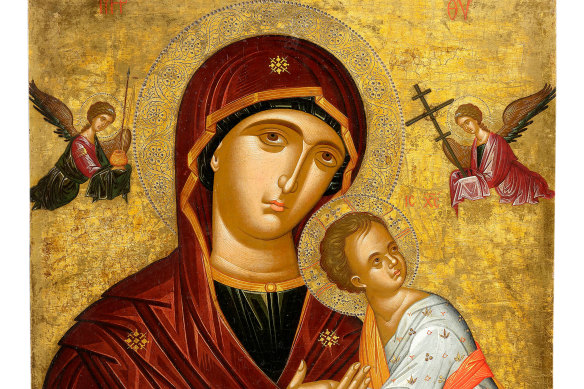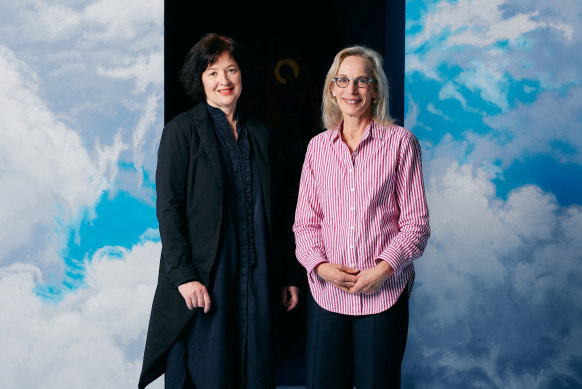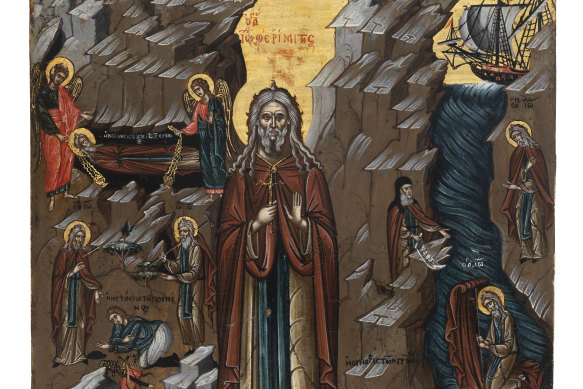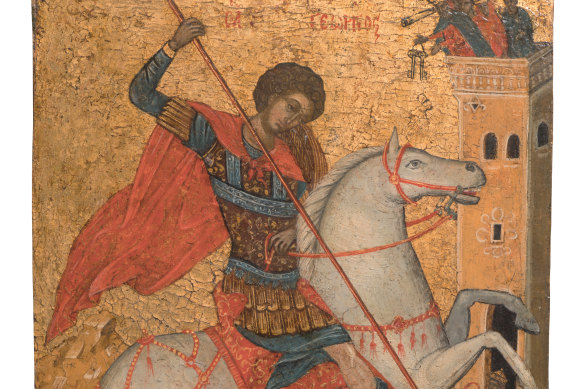For those who’ve been in search of an excuse to instantly fly right down to Hobart, look no additional. Of all of the reveals I remorse seeing late within the day, and all those who most urgently must journey to different venues, Heavenly Beings: Icons of the Orthodox Christian World at David Walsh’s Museum of Previous and New Artwork is prime of each lists.
From its inception, MONA has been a museological maverick and a game-changer, exerting an affect on the best way Australia’s public artwork museums cling their reveals and everlasting collections. Possibly they don’t wish to admit it, however MONA has been the mannequin for all these jumbled shows that mix totally disparate works in the identical room, asking the viewer to seek out mystical, intuitive connections.

Mom of God of the Ardour, Crete, late fifteenth century (element).Credit score: MONA
It really works brilliantly at MONA, however in another venues the dearth of a chronological cling doesn’t provoke a way of marvel, however certainly one of confusion. MONA is a spot through which something goes, however with public artwork museums some expectations and obligations can’t – or shouldn’t – be ignored.
Our public museums appear to imagine these days that each one good issues come from modern artwork. The current is seen as progressive, dynamic and enlightened, whereas the previous is stained with misogyny, racism and colonialism. Moreover, it’s a lot simpler to strike the fitting angle as an apostle of the modern relatively than a scholar of the previous. To enterprise into artwork historical past, one must do a great deal of studying and analysis. Or to provide it one other title: work.

Heavenly Beings curators Sophie Matthiesson & Jane Clark have achieved the work.Credit score: MoNA/Jesse Hunniford
There are many curators who relish the chance to do such work in a discipline of diminishing alternatives. I believe there may be additionally an enormous viewers for historic exhibitions. Look, as an illustration, at Ramses and the Gold of the Pharaohs on the Australian Museum, which is blitzing each native exhibition. One could sneer at so-called “artefact” reveals however nobody is sneering on the attendance figures.
And so we discover MONA swimming towards the tide as soon as extra, holding its first-ever present of completely “previous” artwork. Heavenly Our bodies is an expanded model of an Auckland survey of 2022, itself primarily based on a present on the Artwork Gallery of Ballarat in 2014, which drew on the distinctive personal assortment of former diplomat John McCarthy. The MONA model, introduced collectively by Jane Clark, is essentially the most complete thus far, that includes greater than 120 items, together with loans from a variety of Australian and New Zealand collections.
Earlier curators, Sophie Matthiesson and Gordon Morrison are additionally concerned, making the venture a type of reunion for alumni of the Nationwide Gallery of Victoria. What comes via strongly is the curators’ ardour for his or her topic, which traces the historical past of the icon from 1350 to 1900. It may be thought an retro fixation, however I defy anybody to spend an hour on this present and never be moved by the inventiveness of the work and the air of religious conviction that positively radiates from the partitions.
The primary piece that caught my eye was the top of a Madonna in shiny pink on a yellowed background. Known as Mom of God of the Fiery Face, it relates the Madonna to the burning bush of Exodus 3:2, evaluating her piety to a hearth that’s by no means extinguished, but burns with out destroying the host. The work is comparatively late, being an 18th-century piece from Russia. It appears each previous and astonishingly fashionable.

Saint John the Hermit, Crete, submit seventeenth century (element).Credit score: MONA
No matter its vivid colouration, this Madonna carries the identical expression as quite a few different works within the present, though they could be separated by a whole lot of years. The identical holds true for the face of Christ or different favorite motifs reminiscent of St George. Probably the most well-known icons have been regularly copied for personal use, with numerous small variations.
The motifs could have remained inviolate for hundreds of years, however this exhibition demonstrates how naive it’s to imagine the artwork of the Orthodox Church, sometimes called byzantine, was hieratic, rigid and unchanging. The earliest icons now we have date from the fifth and sixth centuries, lengthy after Emperor Constantine’s conversion to Christianity in AD 312 and the sack of Rome in AD 410. The pictures appear to have grown out of the naturalistic Fayum funerary portraits from Roman Egypt. As a hard and fast repertoire of orthodox motifs emerged, faces would turn out to be flat and stylised, however fixed adjustments occurred, relying on time and place. It’s these temporal and regional variations, stretching throughout 500 years, taking us from Byzantium to Greece, Russia, Jap Europe and Ethiopia, that make this present so engrossing.
At base, the icon custom is eternally related to the Jap Roman Empire, whose capital, Constantinople, spent a millennium as a centre of mercantile, non secular and cultural actions. What turned generally known as the Byzantine Empire would final from 324 to 1453, regardless of being sacked by the Crusaders in 1205. There can be three main phases of the empire earlier than it was lastly extinguished by the Ottomans on Might 29, 1453. From that point onwards, town we now name Istanbul has remained in Turkish fingers.
Over these centuries, icon portray would by levels develop extra stylised or naturalistic. It additionally survived ferocious theological debates about whether or not it was blasphemous to worship the picture of God incarnate or Mary or the saints, versus the summary idea. This resulted in two bouts of iconoclasm, in 726-787 and 815-843, which noticed numerous icons destroyed and their defenders persecuted. The monk, St Stephen the Youthful, turned the primary martyr for an artwork kind when he was dragged via the streets of Constantinople and overwhelmed to loss of life in 764.
An excellent icon wears its scars with the Aristocracy as an indication of how deeply it has been honored.
Finally, the mixed weight of theological experience would come down on the facet of icons, which settled into the central function they’ve performed ever since within the Orthodox faith. These photos have been just too useful when it got here to speaking with a largely illiterate congregation. The icons, stored at house in addition to in church buildings, have been a way of trying instantly into the face of God and recognising his devotion to humanity in taking over mortal flesh. In flip, the acolyte hoped to be integrated inside the Godhead, turning into divine. If the Catholic Church sees Jesus’s sacrifice as expiation for our sins, the Orthodox model views his incarnation as a gesture of cosmic solidarity.
I’m not going any additional into the theology as a result of the complexities of those arguments have made the time period “byzantine” synonymous with one thing so intelligent as to be nearly incomprehensible. There’s additionally an enormous technical vocabulary describing various kinds of icon, regarding which I shall be studiously silent.

St George and the Dragon, Crete, c. 1500 (element).Credit score: MONA
A big a part of the icon’s enchantment was purely superstitious. Well-known icons have been held to be accountable for miracles and claimed to be “not the work of human fingers”. They have been taken from the church and paraded across the streets on feast days and in occasions of disaster. They have been dragged into battle as a allure towards the enemy. For those who have been defeated, it was seen as God’s judgment in your amassed sins.
Most icons are small, painted in tempera or encaustic on a wood panel. Over the centuries, they’ve suffered as a lot harm from their admirers as their detractors via extreme kissing and touching or the smoke from candles. But an awesome icon wears its scars with the Aristocracy as an indication of how deeply it has been honored. These small, concentrated pictures have an imposing presence, introduced out within the MONA present by a cling that clusters items in darkened chambers off a central corridor. In every room, liturgical music performs softly within the background.
Loading
I haven’t gone into depth with particular person works as a result of nearly every bit is a religious vortex, an invite to narrate on to a supernatural world. These weren’t photos to be admired for his or her aesthetic qualities, they have been units meant to convey us nearer to the divine. They’re primal expressions of religion that take God’s incarnation as Jesus Christ as a justification for depicting him in human kind. In Islam, Allah by no means revealed himself on this method and pictures of God stay forbidden.
Some of the spectacular reveals of the yr, Heavenly Beings actually must be touring to different elements of Australia, however I believe this can be a forlorn hope. In these culturally complacent days, each museum customer deserves to see at the very least one exhibition through which the work have a look at you with better depth than you possibly can have a look at them.
Heavenly Beings: Icons of the Orthodox Christian World, Museum of Previous and New Artwork, Hobart. Till April 1
John McDonald flew to Hobart with help from MONA
